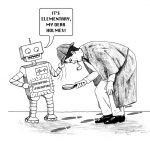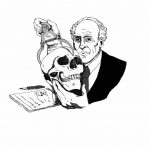This page provides references and capsule descriptions of my recent articles on geometry and topology.
A Tisket, a Tasket, an Apollonian Gasket. American Scientist, Jan.-Feb. 2010, p. 10.
When you inscribe circles inside the spaces between circles ad infinitum, you get a beautiful foam-like figure called an Apollonian gasket. The radii of the circles have fascinating numerical properties that Peter Sarnak and his students are just beginning to uncover. Note: This article was selected for The Best Writing on Mathematics 2011, edited by Mircea Pitici.
A Singular Career, Swarthmore Alumni Bulletin, March 2007
Bob MacPherson’s career as a mathematician has been “singular” in three different ways. He invented intersection homology; he helped rescue Russian mathematics in the economic crisis after the fall of the Soviet regime; and he and Mark Goresky (the Rogers and Hammerstein of mathematics) have become one of the most successful gay couples in mathematics. Too bad a lot of gays aren’t aware of their accomplishments.
Mapping the 248-Fold Way, Science, 23 March 2007.
Mathematicians, with a huge help from computers, succeed in computing a representation table for E8, the most mysterious and exotic of all Lie (pronounced “lee”) groups. This may be relevant to physical theories of the universe; we probably won’t know for a long time. For mathematicians interested in different kinds of symmetry, it is something like the scaling of Mt. Everest or the completion of the Human Genome Project.
The Poincaré Conjecture — PROVED, Science, 22 December 2006.
Science’s editors picked Grigori Perelman’s proof of the Poincaré Conjecture as the Breakthrough of the Year for 2006. I wrote the cover article about it. This gave me a chance to survey and put into context the events of the preceding four years. You’d think that mathematicians would be overjoyed at seeing one of their greatest unsolved problems conquered (and they are), but it has been a bittersweet harvest because of the personal rivalries that have been stirred up.
Perelman Declines Math’s Top Prize; Three Others Honored in Madrid, Science, 25 August 2006.
Grigori Perelman created a huge stir when he declined the Fields Medal (the mathematical equivalent of a Nobel Prize). The reclusive Russian mathematician was the first person in history to do so. However, three other young mathematicians accepted their well-deserved medals from Spain’s King Juan Carlos: Andrei Okounkov of Princeton University, Terence Tao of UCLA, and Wendelin Werner of Université de Paris-Sud.
Taming the Hyperbolic Jungle by Pruning its Unruly Edges, Science, 24 December 2004.
Are you a fan of fractals? Find out what the first fractals were invented for, back in the 1800s. Then learn how topologists are now using them to pin down the geometry of hyperbolic (negatively curved) 3-dimensional universes. Or if that is a little too mind-boggling, just look at the amazing pictures.
Mathematics World Abuzz Over Possible Poincaré Proof, Science, 18 April 2003, 417.
A mathematician goes into relative seclusion for seven years and emerges with a claim that he can prove one of the most famous problems in mathematics. Sound familiar? It happened 10 years ago with Fermat’s Last Theorem, and now it has happened again with the Poincaré Conjecture. But mathematicians, burned often in the past, are being verrry verrry cautious about this claim.
A Fine Mess, New Scientist, 25 May 2002, 32-35.
Packing oranges together is pretty simple in ordinary Euclidean space, but in hyperbolic space it gets seriously weird. Charles Radin of the University of Texas figures out how weird.



